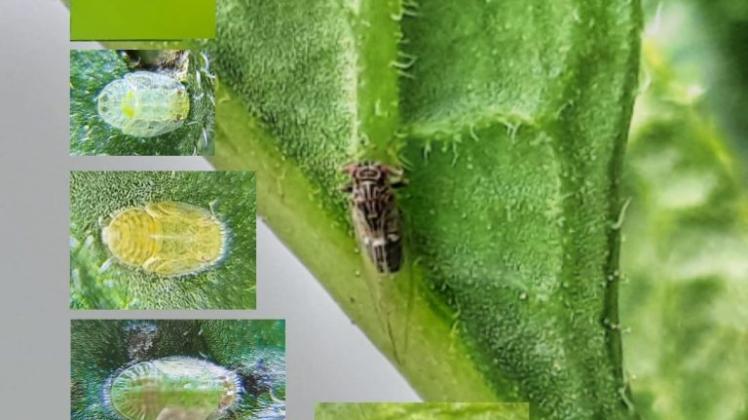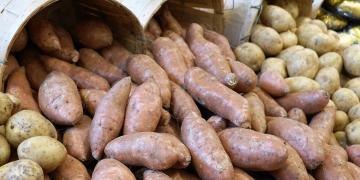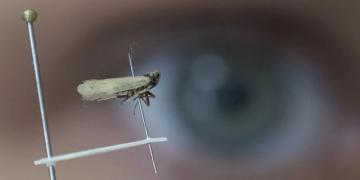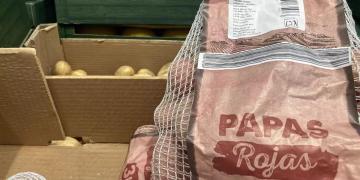Colombia: Impact of the Punta Morada complex on the country’s potato crops
Purple Tip is a disease that causes alterations such as: decreased photosynthetic capacity, impaired nutrient and reserve transport, and malformation and abortion of flowers and fruits.

The insect vector Bactericera cockerelli and the phytoplasmas causing Potato Purple Tip (PMP) Candidatus Phytoplasma spp were reported in Colombia by the Colombian Agricultural Institute - ICA in 2021. In 2023, the ICA also reported the presence of CaLso, Candidatus Liberibacter solanacearum responsible for Zebra Chip disease. By June 2025, this phytosanitary complex was found in 30 municipalities in the department of Nariño and 2 municipalities in the department of Cauca (ICA, 2025) where it has caused economic losses to producers in potato, tree tomato, cape gooseberry, and table tomato crops.
Potato Purple Tip is a disease that causes alterations such as: decreased photosynthetic capacity, impaired nutrient and reserve transport, malformation and abortion of flowers and fruits, and changes in the growth of plants in the Solanaceae family. The main crops affected in Colombia are: potato (Solanum tuberosum L.), tree tomato (Solanum betaceum (Cav)), cape gooseberry (Physalis peruviana L.), table tomato (Solanum lycopersicum L.), and chili pepper (Capsicum annuum L.). The disease is transmitted horizontally, from diseased plants to healthy plants, by the insect vector. Vertically, it is transmitted through the use of seed tubers that are infected by the pathogens (Naspud et al., 2023).
In potatoes, it causes symptoms such as leaflet curling, decreased distance between nodes and thickening, yellow to purple-purple coloration at the edge of the leaflets, formation of aerial tubers in the middle and upper thirds of the plant, dwarfism, stems that grow too much, witch’s broom formation, reduced tuber production and internal browning, which causes rejection by the market; in seeds, some buds do not sprout or their sprouts are threadlike (thin) (Pérez, W et al., 2021).
Zebra chip (ZC) is another disease caused by the bacterium Candidatus Liberibacter solanacearum, which is also transmitted by the insect vector; this bacterium called CaLso is an obligate parasite of the phloem of plants. The characteristic symptom of ZC manifests itself in the flesh of the tuber, a necrotic striation is seen in the vascular ring and in the pith, which when fried in flakes, look like burns in very dark bands that contain high levels of sugars, the disease seriously affects the quality of the seed tuber and emergence, in potato plants it causes yellowing, dwarfing, deformity and wilting, with symptoms similar to those described for PMP.
The potato psyllid, jumping aphid, louse or paratrioza as it is known in the department of Nariño, (Bactericera cockerelli (Sulc)) has a preference for plants of the Solanaceae family. The eggs are elongated, orange in color, suspended on a filament; laid singly, on the underside and edges of leaves; their length is 0.3 mm. The nymphs complete five instars, are oval in shape, flattened dorso-ventrally, with defined eyes, and are covered in waxy filaments; their size is 0.4 - 1.65 mm in length. The adults emerge green - yellow in color, their wings are white that after 4 hours become transparent, the body turns from amber to dark brown or black. The thorax is yellowish white with brown spots, the length of the wings is 1.5 times the length of the body, its size is 2.8 to 3.0 mm in length (ICA, 2021).
Lines of research in development
AGROSAVIA, with funding from the Ministry of Agriculture and Rural Development (MADR) during 2021-2023 and through derivative agreement 1 of inter-administrative framework agreement No. 017 of 2023 AGROSAVIA-ICA (2188) during 2023-2024, has developed multiple lines of research to understand and manage the Punta Morada de la Papa complex. These investigations cover from fundamental aspects of the complex to field management strategies, and are grouped as follows: I) characterization of the symptoms of the PMP complex in cape gooseberry, tree tomato, table tomato and chili, II). techniques for detecting pathogens in the laboratory, III) studies of B. cockerelli population fluctuation in farms established with potato crops (Criolla Colombia, Superior and Diacol Capiro) in three contrasting environments, IV) establishment of the spectral signature of PMP through the analysis of images captured with drones for remote sensing of the disease, V) models that allow evaluating the risk of the vector in producing areas of Cundinamarca, Boyacá and Antioquia due to agroclimatic conditions; maps of potential distribution of B. cockerelli were generated from the Maxent model (distribution of related niches for the vector) and with the ILCYM model (geographic affinity zones for the insect based on its optimal temperature range), VI) validation of bioproducts for vector control, VII) determination of true hosts, VIII) determination of natural enemies and IX) validation of integrated PMP management techniques in potato plots developed on farmer farms.
Progress in the transfer process: The strategy and its projection
Since the presence of the Punta Morada complex was confirmed in the department of Nariño in 2021, AGROSAVIA has established a strategic alliance with the ICA (National Institute of Statistics and Census) to develop a comprehensive program for risk awareness, disease prevention, and mitigation. This initiative has covered both the affected department and areas still free of the complex, including Antioquia, Boyacá, Caldas, Cauca, Cundinamarca, Santander, and Tolima.
The training program has achieved significant results with the implementation of 74 workshops for 1,497 farmers, 20 specialized workshops for 508 technical assistants, and eight field days in five demonstration plots of mitigation strategies that benefited 239 sector stakeholders. Additionally, two technology refresher sessions were held with 179 participants and three virtual seminars reached 202 stakeholders, consolidating a multimodal approach to knowledge transfer.
Risk management workshops in free zones.
The mass dissemination of knowledge has been strengthened through the production and distribution of diverse audiovisual materials, including videos, music videos, podcasts, radio spots, booklets, fact sheets, brochures, fact sheets, and calendar posters. These materials have been distributed in both physical and digital formats via WhatsApp, text messages, and email, seeking a broad territorial reach.
A notable innovation in the strategy has been the implementation of the Citizen Monitoring Network for the Punta Morada Solanaceae Complex in Nariño, which has actively involved rural youth in the department in outreach, prevention, and mitigation activities. This network has carried out participatory monitoring of potato, tree tomato, and table tomato crops, training 556 rural youth between 2022 and 2024. These youth have collected valuable information on the presence of Bactericera cockerelli and the characteristic symptoms of the disease in 141 plots distributed across 10 municipalities in Nariño.
Advances in inter-institutional and project management work. Analysis and leveraging interactions between institutions.
Following the official ICA report on the presence of the purple-tip vector (the potato psyllid) and the phytoplasmas that cause the disease in Colombia, comprehensive management, research, and technology transfer actions have been implemented to train and empower the various stakeholders in the sector, while simultaneously strengthening national capacities to address this phytosanitary challenge.
The institutional response has been articulated primarily through the Nariño Regional Technical Roundtable, established in 2021 as a strategic space for inter-institutional exchange and coordination. This platform has brought together MADR, ICA, AGROSAVIA, the Colombian Federation of Potato Producers (Fedepapa), the University of Nariño, the Nariño Secretariat of Agriculture, and other relevant entities in the sector. As a tangible result of this collaboration, four issues of a technical bulletin were issued in 2022, systematically documenting the progress made in ongoing projects. Inter-institutional support has catalyzed specific high-impact results, such as:
– The formation of a specialized technical group to monitor, research, and provide direct support to the production sector.
– The strategic coordination of knowledge management actions and training programs aimed at researchers, officials, technical assistants, operational staff, and producers
– And the organization and participation in national and international meetings that have facilitated the exchange of experiences with organizations in Colombia, Peru, and Ecuador, countries facing similar problems.
Research projects have been structured through specialized groups that seek to deepen knowledge of the Punta Morada complex in Colombia and generate applicable short-term management recommendations. Each institution has adopted specific areas based on its institutional mission: the ICA has focused on surveillance, detection, and diagnosis, while AGROSAVIA has developed research on the complex’s effect on crops of interest, detection and monitoring techniques, development of control methods, and validation and adjustment processes for management under field conditions.
Throughout the transfer process, the institutions have shared a premise of disseminating available knowledge to as many stakeholders as possible. The participation of the Secretariats of Agriculture of Antioquia, Cauca, Boyacá, Cundinamarca, and Nariño has been fundamental to the success of the workshops held in these departments, providing access to additional dissemination channels and significantly expanding the number of participants in areas still free of the problem. This cooperation has been instrumental in effectively delivering the awareness and prevention message to strategic territories.
International cooperation has opened up opportunities to formulate joint research proposals submitted to various calls, with the first projects already approved for short-term implementation. The MADR (Research and Development Agency) has funded four initiatives developed by AGROSAVIA between 2021 and 2024. Although short-term (no more than one year each), these initiatives have sequentially consolidated knowledge and transferred it to various stakeholders in Nariño and other departments of the country.
Institutional work teams and inter-institutional committees actively manage research and transfer project proposals in close interaction with the productive sector, ensuring the continuity and evolution of the strategies implemented for the comprehensive management of the Punta Morada complex in Colombia.
Management recommendations in affected and free areas
To reduce the risk of PMP complex in free zones the key aspects are:
Expand your knowledge of the complex: learn to recognize disease symptoms and the insect vector. Search, study, and review the informational materials available in digital or print media. Participate in training activities organized by the ICA, AGROSAVIA, or associations related to this issue.
Use quality seed: prefer to use ICA-certified seed. Know the origin of the seed used and avoid using material from areas suspected of having PMP, collection centers, or potato retailers. When planting, increase the distance between rows to facilitate monitoring and control.
Monitor the crop: Conduct weekly inspections to detect the insect or symptoms associated with the disease. Pay special attention to the undersides of leaves, where potato psyllid eggs, nymphs, and adults can be observed. Also, check nearby plants such as cape gooseberry, chili peppers, table tomatoes, tree tomatoes, and weeds in the Solanaceae family like nightshade, as they can also be affected by the PMP complex and be hosts for the insect vector.
Report to ICA: If you identify insect stages (egg, nymph, or adult) or suspect the presence of PMP symptoms in your plants or those of your neighbors, immediately report it to the nearest ICA, AGROSAVIA, or the guild office.
If you are in an area where PMP is present, in addition to the above recommendations, please note the following:
Manage the insect vector in a timely manner: monitor the field to verify the presence of the insect or its population changes. Use yellow traps and directly observe the plants. As of June 2025, ten commercial products are ICA-registered for psyllid control in potato crops. Resolution ICA103325 of 2021 also includes other authorized insecticides. Rotate the mode of action of these insecticides within the same crop cycle. Consult an agronomist for the proper implementation of this recommendation.
Avoid transporting the insect: Clean your tools before using them on another field. Wear separate clothing or biosecurity suits if you visit multiple production fields to prevent the insect from spreading.
Dispose of residues properly: Apply insecticides and herbicides to crop residues to eliminate green tissue that could harbor the vector. If green tissue remains on the soil, collect it and bury it in a pit.
Control potato sprouts: Remove potato plants that emerge weeks after harvest, as these provide shelter and food for the insect vector.
Conclusions and projections
The communication and dissemination strategy for the PMP complex has proven effective in raising awareness among key stakeholders; however, it requires expansion to include a more diverse range of participants in the agricultural sector, including farmers, technical assistants, agricultural warehouses, and rural students. This expansion demands strategic coordination among institutions such as ICA, Fedepapa, Asohofrucol, AGROSAVIA, ADR, agricultural secretariats, SENA, and universities, with the goal of implementing structured training and technology transfer plans that guarantee long-term continuity and the constant generation of new knowledge.
Priority lines of research include in-depth epidemiological studies to identify crop-specific risk zones, the optimization of surveillance and detection techniques using spectral fingerprinting with drones and molecular tools, and the development of predictive models to facilitate preventive decision-making. It is essential to develop integrated management strategies that incorporate ongoing monitoring, biological control with natural predators and entomopathogenic fungi, biorational products, and the optimization of chemical management, covering crops such as potatoes, cape gooseberries, tree tomatoes, and table tomatoes.
I understand.The research agenda should be complemented with studies on potential vectors through massive DNA sequencing, identification of host solanaceous plants, evaluation of potato germplasm resistance, and a comprehensive analysis of the impact on sustainability, considering economic (production costs and yield losses), environmental (increased use of agrochemicals), and cultural (productive reconversion processes) aspects. The success of these initiatives depends on maintaining strong inter-institutional coordination that optimizes available resources and strengthens the trust of stakeholders in production chains, especially producers, recognizing the valuable joint learning developed since 2021 with multiple national and international stakeholders.
Literature
Gamarra H., Andrade-Piedra J., Pérez W., Navarrete I., Panchi N., Castillo C., Espitia E., Arango E., and Kreuze J. 2024. Report of the International Workshop on the Punta Morada Complex: Problems and Implications for Latin America. CGIAR. Plant Health Initiative. 6pp. DOI: 10.4160/cip.2024.01.002
Colombian Agricultural Institute (ICA). (2021). The ABC of purple tip, potato zebra chip, and its vector, Bactericera cockerelli Sulc (Hemiptera:Triozidae).
Colombian Agricultural Institute (ICA). (2025). Integrated technological surveillance with predictive modeling: advances against HLB in citrus, Xylella fastidiosa, and the Bactericera cockerelli Punta Morada and Zebra Chip complex in Solanaceae. In Symposium: Interaction between insect vectors, phytopathogenic microorganisms, and plants: implications for the transmission and management of regulated pests in Colombia. 52nd Congress of the COLOMBIAN SOCIETY OF ENTOMOLOGY SOCOLEN, June 25-27, Santa Martha, Colombia.
Naspud, J.N., Panchi, N., Gamarra, H., Carhuapoma, P., Prado, J., Castillo, C., & Kreuze, J. (2023). Life cycle of Bactericera cockerelli under controlled and fluctuating conditions. In M. Racines, X. Cuesta, B. Montero, P. Cuasapaz, N. Panchi, & H. Benavidez (Eds.), Proceedings of the 10th Ecuadorian Potato Congress (pp. 116–118).
Pérez, W., Castillo Carrillo, C., Navarrete, I., Gamarra, H., Arango, E., Naccha, J., and Andrade-Piedra, J.L. 2021. Primer for the identification of symptoms of purple top disease in potatoes. Series: Emerging pests of potato crops in Latin America. Training material 3. International Potato Center (CIP), National Agricultural Research Institute (INIAP), National Agrarian Health Service (SENASA). Lima, Peru.
Fuente:








